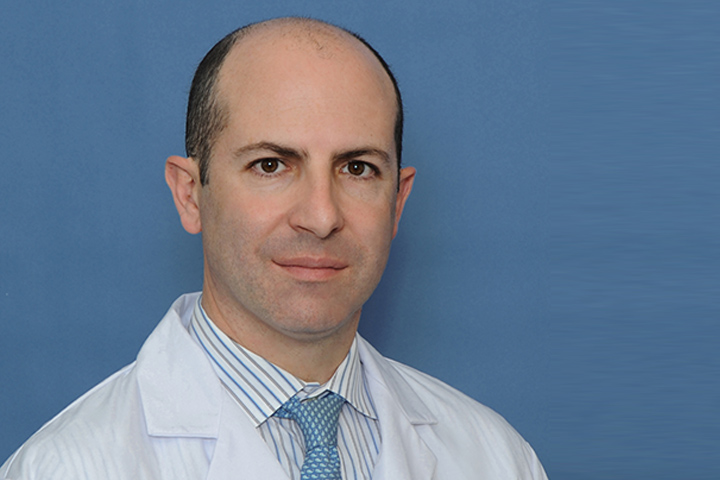Targeting the Undruggable KRAS Protein

The seemingly undruggable KRAS mutation—present in about 90% of pancreas cancers—may have met its match with new approaches and targeted therapies.
This important protein acts as a kind of switch, regulating cell growth. When cells are healthy, the KRAS switch turns on and off. But in cancer cells it is stuck in an “on” position, activating numerous pathways that allow cells to grow, divide, and spread, a hallmark of cancer. Scientists discovered that KRAS turns on and off by binding to a molecule called GTP (guanosine triphosphate). When the process goes as it should, GTP is converted into GDP (guanosine diphosphate), which shuts off this uncontrolled growth. The problem is figuring out how to shut off that switch when things go wrong.
“The problem with KRAS is that it’s smooth like a shiny ball that lacks any deep grooves or pockets where we can get a drug to bind to it,” explains Shubham Pant, M.D., Associate Professor of Gastrointestinal Medical Oncology and Investigational Cancer Therapeutics, and Associate Director, Early Phase Drug Development, Sheikh Ahmed Bin Zayed Al Nahyan Center for Pancreatic Cancer Research, at the University of Texas MD Anderson Cancer Center, Houston. “Plus, KRAS is tightly bound to GTP in its activated state, making targeting even more challenging.”
So physician-scientists are trying to find a work-around. Now, they are looking at the possibility of blocking very specific mutations. KRAS mutations, it seems, can be divided into different groupings. One type of KRAS mutation, KRAS G12C, accounts for about 44% of all KRASmutations and is particularly prevalent in non-small cell lung cancers, but it is also found in approximately 1% of patients with pancreatic cancer. Other groupings include KRAS G12D, KRAS G12V, and KRAS G12R. “What we’re trying to do is to try and target these mutations, as they are all different cancers,” says Pant. “Then potentially we can target them with selective agents.”
How Drugs Can Reach Their Targets
How to get those drugs to their targets is the focus of much research. One way may be to use the body’s own cell-to-cell communication delivery service, called an exosome. An exosome’s job is to deliver proteins and other genetic information to cells. Right now, millions of exosomes are racing through our bodies delivering proteins and other genetic information to nearby and distant cells.
Researchers hope to give exosomes one more job to do: solve drug delivery problems for numerous therapies, including the problems associated with drugging mutant KRAS. “Think of exosomes as a kind of Amazon delivery service of the body,” explains Pant. They act as messengers that facilitate communication between cells. In mouse models, exosomes were used to deliver a treatment called small interfering RNA (siRNA). These “iExosomes” are capable of delivering small RNA to specifically target mutant KRAS. This resulted in disease suppression and increased overall survival in mouse models.
New Approaches
At MD Anderson, a trial is currently underway studying mesenchymal stromal cells-derived exosomes with KRAS G12D siRNA (iExosomes) in patients with KRAS G12D metastatic pancreatic cancer. As an early-stage trial, the objective is to identify the maximum tolerated dose of exosomes-loaded siRNA against KRAS G12D mutation.
Other early-stage trials are taking different approaches. One multisite trial is testing two medicines called BI 1701963 and trametinib. BI 1701963 is an “SOS inhibitor” that acts by preventing reactivation of KRAS by binding to the SOS1 gene, thus blocking the formation of KRAS in the active or “on” state. This drug is being given to humans for the first time. Trametinib is an approved medicine (MEK inhibitor), currently used for treating melanoma. MEK1 and MEK2 proteins are within the cancer cell and are part of a pathway called MAPK, which is directed by KRAS. One of the purposes of this study is to find out the highest tolerable dose of BI 1701963 alone and in combination with trametinib. Another purpose is to check whether BI 1701963 in combination with trametinib is able to make tumors with KRAS mutations shrink.
Another trial is combining MEK inhibitor binimetinib and hydroxychloroquine to block KRAS in patients with advanced pancreatic cancer. “When they’re used alone, MEK or ERK inhibitors have not been shown to have clinical benefit for patients with pancreatic cancer and KRAS mutations,” Pant adds. “But in lab experiments, blocking the MEK-ERK pathway leads to a dependence of pancreatic cancer on autophagy (the body’s way of getting rid of damaged cells so new cells can take their place) for survival, leading to this becoming a major target for cancer therapy. Hydroxychloroquine is an inhibitor of autophagy, and combining it with MEK and ERK inhibitors has demonstrated benefit in preclinical experiments and is the basis for the current trial.”
The Future Is Bright
As more targeted approaches are developed, physician–scientists can now potentially target KRAS mutations with newer agents, alone or in combination with both direct and downstream KRAS inhibitors.
Pant considers himself both an optimist and a realist. “With pancreatic cancer it sometimes seems like we are taking one step forward only to take two steps back,” he says. “It wasn’t that long ago that there were very limited options for lung cancer patients. But today the treatment paradigm has dramatically changed. I believe the same will hold true for pancreatic cancer. I’m very optimistic for the future with the advent of and interest in all these new agents that are finally trying to crack the ’undruggable’ code.” He adds: “There’s much more interest from academic labs, pharmaceutical companies, and a persistent and dedicated team of physicians and scientists who want to make a dent in this disease. We hope to enroll more than 200 patients with pancreatic cancer on therapeutic trials this year at MD Anderson, strengthening our commitment and resolve to making true progress in this disease.”






